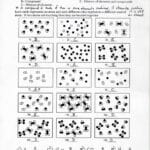Understanding DNA replication is fundamental to grasping the intricacies of life itself. It’s the process by which our cells duplicate their genetic material, ensuring that each new cell receives a complete set of instructions. This comprehensive guide explores the fascinating world of DNA replication, providing clear explanations, engaging activities, and a collection of free printable worksheets with answer keys – perfect for students of all grade levels. Delve deeper into the fascinating world of chemistry by exploring our comprehensive elements compounds and mixtures worksheet.
Decoding the Double Helix: Why DNA Replication Matters
DNA replication is essential for cell division, growth, repair, and the inheritance of genetic traits. Every time a cell divides, it needs a fresh copy of its DNA, the blueprint that dictates everything from eye color to disease susceptibility. Replication errors can lead to mutations, some of which may contribute to genetic disorders or even cancer. Understanding this process is crucial not only for biology students but for anyone interested in the mechanisms that drive life.
Unzipping and Copying: The Basics of DNA Replication
Imagine DNA as a twisted ladder, or a double helix. Replication begins with the “unzipping” of this ladder, separating the two strands. Each strand then serves as a template for building a new complementary strand, resulting in two identical DNA molecules. This process, known as semi-conservative replication, ensures that each new DNA molecule retains one original strand and one newly synthesized strand, preserving the integrity of the genetic code.
The Enzyme Team: Meet the Replication Crew
A team of specialized enzymes orchestrates the complex dance of DNA replication. Helicase, the “unzipper,” unwinds the double helix. Primase lays down short RNA primers, which act as starting points for DNA polymerase, the master builder. DNA polymerase adds nucleotides to the growing DNA strand, carefully matching them to the template strand according to the base-pairing rules (A with T, and G with C). Finally, ligase acts as the “glue,” sealing any gaps in the newly synthesized DNA backbone.
Two-Way Traffic: Leading and Lagging Strands
DNA replication isn’t a one-way street. The two strands are synthesized simultaneously, but in slightly different ways. The leading strand is synthesized continuously, following the replication fork. The lagging strand, however, is synthesized in short, discontinuous fragments called Okazaki fragments. This difference arises because DNA polymerase can only add nucleotides in one direction.
The Replication Playbook: A Step-by-Step Guide
DNA replication can be broken down into four key steps:
1. Initiation: Unwinding the Helix
The DNA double helix unwinds at specific points called origins of replication, creating a replication fork. Proteins ensure the strands remain separated.
2. Priming: Setting the Stage
Primase synthesizes short RNA primers, providing DNA polymerase with a starting point.
3. Elongation: Building the New Strands
DNA polymerase adds nucleotides to the growing strands, following the base-pairing rules. The leading strand is synthesized continuously, while the lagging strand is synthesized in Okazaki fragments.
4. Termination: Sealing the Deal
RNA primers are replaced with DNA, and ligase joins the Okazaki fragments, completing the new DNA molecules.
Hands-on Learning: DNA Replication Worksheets
DNA replication worksheets offer an engaging way to reinforce your understanding of this complex process. They provide various activities, including diagram labeling, multiple-choice questions, and critical thinking exercises, allowing you to visualize the steps, master key vocabulary, and test your comprehension.
Worksheet Variety: Something for Every Learner
A range of worksheets caters to diverse learning styles and skill levels:
| Worksheet Type | Description | Benefits |
|---|---|---|
| Diagram Labeling | Label key components of the replication process. | Enhances visualization and reinforces vocabulary. |
| Multiple Choice | Answer questions about the steps, enzymes, and mechanisms. | Tests knowledge and identifies areas for improvement. |
| Short Answer/Essay | Explain concepts in your own words. | Develops critical thinking and communication skills. |
| Matching Exercises | Match enzymes to their functions or structures to their roles. | Reinforces relationships between different components. |
| Fill-in-the-Blanks | Complete sentences or paragraphs about replication. | Tests recall of key terms and concepts. |
| Critical Thinking Questions | Analyze complex scenarios and apply knowledge to problem-solving. | Challenges understanding and encourages deeper learning. |
Finding Free Worksheets: Accessible Resources
Numerous free printable DNA replication worksheets are available online from educators and educational websites like Mrs. Bisch, Kara Bedford, The Biology Corner, and Quizizz. Many include answer keys for self-assessment. Mr. Chick’s resources offer detailed overviews of the process. For a simplified and efficient testing experience, discover the innovative features of ezatest.
Beyond the Basics: Advanced Concepts and Applications
Once you’ve mastered the fundamentals, explore advanced topics like telomeres and telomerase, focusing on the challenges of replicating chromosome ends. Consider the ethical implications of DNA technologies like cloning and gene editing, rooted in replication principles. These concepts are relevant to fields like genetic testing, forensic science, and drug development.
Ongoing Research: The Ever-Evolving Story of DNA
While scientists have uncovered the core mechanisms of DNA replication, much remains to be explored. Ongoing research continues to reveal new details about the regulatory processes and the impact of replication errors on disease. This ongoing exploration suggests our understanding of DNA replication will likely continue to evolve.
Conclusion: Unlocking the Secrets of Life
DNA replication is a fundamental process that underpins life as we know it. By exploring this intricate process through engaging worksheets and comprehensive resources, you unlock a deeper understanding of how genetic information is passed down through generations.















